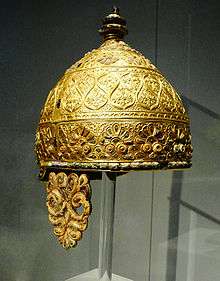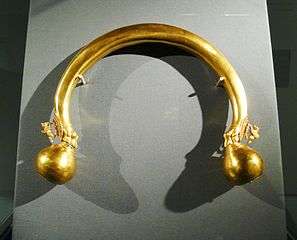Prehistory of France
Part of a series on the |
||||||||||||||||||
|---|---|---|---|---|---|---|---|---|---|---|---|---|---|---|---|---|---|---|
| History of France | ||||||||||||||||||
   | ||||||||||||||||||
|
||||||||||||||||||
|
||||||||||||||||||
|
||||||||||||||||||
|
||||||||||||||||||
|
||||||||||||||||||
|
||||||||||||||||||
| Timeline | ||||||||||||||||||
|
| ||||||||||||||||||
Prehistoric France is the period in the human occupation (including early hominins) of the geographical area covered by present-day France which extended through prehistory and ended in the Iron Age with the Celtic "La Tène culture".
Stone tools indicate that early humans were present in France at least 1.57 million years ago.[1]
The Palaeolithic
Lower Palaeolithic

Stone tools discovered at Lézignan-la-Cèbe in 2009 indicate that early humans were present in France at least 1.57 million years ago.[1]
France includes Olduwan (Abbevillian) and Acheulean sites from early or non-modern (transitional) Hominini species, most notably Homo erectus and Homo heidelbergensis. Tooth Arago 149 - 560,000 years. Tautavel Man (Homo erectus tautavelensis), is a proposed subspecies of the hominid Homo erectus, the 450,000-year-old fossil remains of whom were discovered in the Arago Cave in Tautavel.
The Grotte du Vallonnet near Menton contained simple stone tools dating to 1 million to 1.05 million years BC.[2] Cave sites were exploited for habitation, but the hunter-gatherers of the Palaeolithic era also possibly built shelters such as those identified in connection with Acheulean tools at Grotte du Lazaret and Terra Amata near Nice in France. Excavations at Terra Amata found traces of the earliest known domestication of fire in Europe, from 400,000 BC.[2]
Middle Palaeolithic
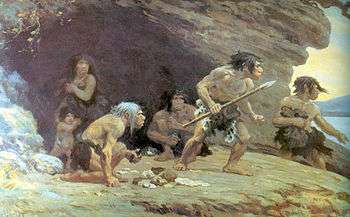
The Neanderthals, the earliest human species to occupy Europe, are thought to have arrived there around 300,000 BC, but seem to have died out by about by 30,000 BC, presumably unable to compete with modern humans during a period of cold weather. Numerous Neanderthal, or "Mousterian", artifacts (named after the type site of Le Moustier, a rock shelter in the Dordogne region of France) have been found from this period, some using the "Levallois technique", a distinctive type of flint knapping developed by hominids during the Lower Palaeolithic but most commonly associated with the Neanderthal industries of the Middle Palaeolithic. Importantly, recent findings suggest that Neandertals and modern humans may have interbred.[3]
Upper Palaeolithic
The earliest modern humans – Cro-Magnons – were present in Europe by 43,000 years ago during a long interglacial period of particularly mild climate, when Europe was relatively warm, and food was plentiful.[4] When they arrived in Europe, they brought with them sculpture, engraving, painting, body ornamentation, music and the painstaking decoration of utilitarian objects. Some of the oldest works of art in the world, such as the cave paintings at Lascaux in southern France, are datable to shortly after this migration.
European Palaeolithic cultures are divided into several chronological subgroups (the names are all based on French type sites, principally in the Dordogne region):
- Aurignacian (c. 38,000 - 23,000 BP) – responsible for Venus figurines, cave paintings at the Chauvet Cave (continued during the Gravettian period).
- Périgordian (c. 35,000 - 20,000 BP) – use of this term is debated (the term implies that the following subperiods represent a continuous tradition).
- Châtelperronian (c. 39,000 - 29,000 BP) – culture derived from the earlier, Neanderthal, Mousterian industry as it made use of Levallois cores and represents the period when Neanderthals and modern humans occupied Europe together.
- Gravettian (c. 28,000 - 22,000 BP) – responsible for Venus figurines, cave paintings at the Cosquer Cave.
- Solutrean (c. 22,000 - 17,000 BP)
- Magdalenian (c. 17,000 - 10,000 BP) – thought to be responsible for the cave paintings at Pech Merle (in the Lot in Languedoc, dating back to 16,000 BC), Lascaux (located near the village of Montignac, in the Dordogne, dating back to somewhere between 13,000 and 15,000 BC, and perhaps as far back as 25,000 BC), the Trois-Frères cave and the Rouffignac Cave also known as The Cave of the hundred mammoths. It possesses the most extensive cave system of the Périgord in France with more than 8 kilometers of underground passageways.
Experts sometimes refer to the "Franco-Cantabrian region" to describe this densely populated region of southern France and northern Spain in the late Palaeolithic.
-
Solutrean stone tool.
-
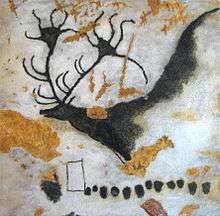
Cave painting of a Megaloceros in Lascaux.
-

Front and side view of the Venus of Brassempouy.
The Mesolithic
From the Paleolithic to the Mesolithic, the Magdalenian culture evolved. In South-West France and Spain, one finds the Azilian culture of the Late Glacial Maximum which co-existed with similar early Mesolithic European cultures such as the Tjongerian of North-Western, the Ahrensburgian of Northern and the Swiderian of North-Eastern Europe, all succeeding the Federmesser complex. The Azilian culture was followed by the Sauveterrian in Southern France and Switzerland, the Tardenoisian in Northern France, the Maglemosian in Northern Europe.
Archeologists are unsure whether Western Europe saw a Mesolithic immigration. If Gravettian or Epipaleolithic immigrants to Europe were indeed Indo-European, then populations speaking non-Indo-European languages are obvious candidates for previous Paleolithic remnants. The Vascons (Basques) of the Pyrenees present the strongest case, since their language is related to none other in the world, and the Basque population has a unique genetic profile. The disappearance of the Doggerland affected the surrounding territories. The Doggerland population had to go as far as northern France and eastern Ireland to escape from the floods.
The Neolithic
The Neolithic period lasted in northern Europe for approximately 3,000 years (c. 4500 BC–1700 BC). It is characterised by the so-called Neolithic Revolution, a transitional period that included the adoption of agriculture, the development of tools and pottery (Cardium Pottery, LBK), and the growth of larger, more complex settlements. There was an expansion of peoples from southwest Asia into Europe; this diffusion across Europe, from the Aegean to Britain, took about 2,500 years (6500 BC–4000 BC). Some archaeologists believe that this expansion, marking the eclipse of Mesolithic culture, coincided with the introduction of Indo-European speakers, whereas linguists prefer to see Indo-European languages introduced during the succeeding Bronze Age. Within the framework of this latter theory (the Kurgan hypothesis), which remains the most commonly accepted model of Indo-European expansion, Neolithic peoples in Europe are called "Pre-Indo-Europeans" or "Old Europe".
Many European Neolithic groups share basic characteristics, such as living in small-scale family-based communities, subsisting on domestic plants and animals supplemented with the collection of wild plant foods and with hunting, and producing hand-made pottery (that is made without the potter's wheel). Archeological sites from the Neolithic in France include artifacts from the Linear Pottery culture (c. 5500-4500 BC), the Rössen culture (c. 4500—4000 BC), and the Chasséen culture (4,500 - 3,500 BC; named after Chassey-le-Camp in Saône-et-Loire), the name given to the late Neolithic pre-Beaker culture that spread throughout the plains and plateaux of France, including the Seine basin and the upper Loire valleys.
"Armorican" (Brittany) and Northern French neolithic culture is based on traditions of the Linear Pottery culture or "Limburg pottery" in association with the La Hoguette culture.
It is most likely from the Neolithic that date the megalithic (large stone) monuments, such as the dolmens, menhirs, stone circles and chamber tombs, found throughout France, the largest selection of which are in the Brittany and Auvergne regions. The most famous of these are the Carnac stones (c. 3300 BC, but may date to as old as 4500 BC) and the stones at Saint-Sulpice-de-Faleyrens.
-
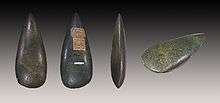
Polished stone axe - Muséum de Toulouse.
-
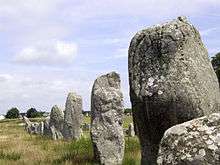
The Menec alignments, the most well-known megalithic site amongst the Carnac stones.
-
Cairn of Barnenez is one of the World's oldest monumental grave.
The Copper Age
During the Chalcolithic or Copper Age, a transitional age from the Neolithic to the Bronze Age, France shows evidence of the Seine-Oise-Marne culture and the Beaker culture.
The Seine-Oise-Marne culture or "SOM culture" (c. 3100 to 2400 BC) is the name given by archaeologists to the final culture of the Neolithic in Northern France around the Oise River and Marne River. It is most famous for its gallery grave megalithic tombs which incorporate a port-hole slab separating the entrance from the main burial chamber. In the chalk valley of the Marne River rock-cut tombs were dug to a similar design.
Beginning about 2600 BC, the Artenacian culture, a part of the larger European Megalithic Culture, developed in Dordogne, possibly as a reaction to the advance of Danubian peoples (such as SOM) over Western France. Armed with typical arrows, they took over all Atlantic France and Belgium by 2400 BC, establishing a stable border with the Indo-Europeans (Corded Ware) near the Rhine that would remain stable for more than a millennium.
In the Southeast, several groups whose culture had evolved from Chasséen culture also built megaliths.
The Beaker culture (c. 2800–1900 BC) is a wide phenomenon that expanded over most of France, excluding the Massif Central, without significatively altering the pre-existing cultures.
The Bronze Age
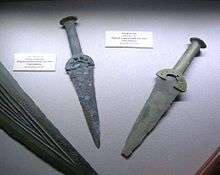
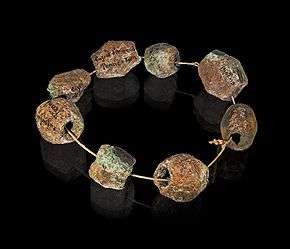
The early Bronze Age archeological cultures in France include the transitional Beaker culture (c. 2800–1900 BC), the Tumulus culture (c. 1600-1200 BC) and Urnfield culture (c. 1300-800 BC). Bronze Age sites in Brittany are believed to have grown out of Beaker roots, with some Wessex culture and Unetice culture influence. Some scholars think that the Urnfield culture represents an origin for the Celts as a distinct cultural branch of the Indo-European family (see Proto-Celtic). This culture was preeminent in central Europe during the late Bronze Age; the Urnfield period saw a dramatic increase in population in the region, probably due to innovations in technology and agricultural practices.
Some archeologists date the arrival of several non-Indo-European peoples to this period, including the Iberians in southern France and Spain, the Ligures on the Mediterranean coast, and the Vascons (Basques) in southwest France and Spain.
The Iron Age
The spread of iron-working led to the development of the Hallstatt culture (c. 700 to 500 BC) directly from the Urnfield. Proto-Celtic, the latest common ancestor of all known Celtic languages, is generally considered to have been spoken at the time of the late Urnfield or early Hallstatt cultures, in the early 1st millennium BC.
The Hallstatt culture was succeeded by the La Tène culture, which developed out of the Hallstatt culture without any definite cultural break, under the impetus of considerable Mediterranean influence from Greek, and later Etruscan civilizations. The La Tène culture developed and flourished during the late Iron Age (from 450 BC to the Roman conquest in the 1st century BC) in eastern France, Switzerland, Austria, southwest Germany, the Czech Republic, and Hungary. Farther to the north extended the contemporary Pre-Roman Iron Age culture of Northern Germany and Scandinavia.
In addition, Greeks and Phoenicians settled outposts like Marseille in this period (c. 600 BC).
By the 2nd century BC, Celtic France was called Gaul by the Romans, and its people were called Gauls. The people to the north (in what is present-day Belgium) were called Belgae (scholars believe this may represent a mixture of Celtic and Germanic elements) and the peoples of the south-west of France were called the Aquitani by the Romans, and may have been Celtiberians or Vascons.
-
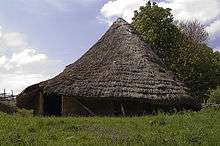
Reconstruction of a Celtic house.
Timeline
Prehistoric and Iron Age France - all dates are BC
- 1,800,000 (Date not considered secure) : Appearance of stone tools (possibly by Homo erectus) in France (Chilhac, Haute-Loire).
- 1,570,000:Stone tools at Lézignan-la-Cèbe.
- 1,050,000 to 1,000,000: stone tools at Grotte du Vallonnet, near Menton.
- 900,000: Beginning of Günz glaciation.
- 700,000: Oldest shaped tools in Brittany.
- 600,000: Beginning of Günz-Mindel interglacial. Appearance of Homo heidelbergensis in Europe.
- 450,000: "Tautavel man" (possibly Homo heidelbergensis).
- 410,000: Beginning of Mindel glaciation (Mindel I). Abbevillian culture, taming of fire.
- 400,000: Mindel II. Shards of "proto-Levallois" tools.
- 400,000 to 380,000: Traces of first domestication of fire at Terra Amata (Nice).
- 300,000: Beginning of Mindel-Riss interglacial.
- 300,000: Appearance of Neanderthals in Europe.
- 200,000: Beginning of Riss glaciation (Riss I).
- 190,000: Riss II.
- 140,000: Riss III.
- 130,000: Beginning of Riss-Würm interglacial.
- 70,000: Beginning of Würm glaciation.
- 62,000: Würm I/II interglacial.
- 57,000: Brorup interglacial.
- 55,000: Würm II.
- 40,000: Laufen interglacial. Arrival of first modern humans (Cro-Magnons) in Europe.
- 35,000: Würm IIIa. Châtelperronian culture.
- 33,000: Mask of la Roche-Cotard, a Mousterian artefact.
- 32,000: Aurignacian culture.
- 30,000: First statuettes and engravings in France. Disappearance of Neanderthals.
- 28,000: Arcy interglacial.
- 27,500: Würm IIIb.
- 25,000: Paudorf interglacial.
- 23,000: Würm IIIc.
- 18,000: End of Würm glaciation.
- 18,692: Beginning of Solutrean culture.
- 16,000: Cold spell (Oldest Dryas).
- 15,000: Magdalenian culture.
- 15,300: Lascaux.
- 14,500: Middle Magdalenian. Bølling Oscillation.
- 14,100: Cold spell (Older Dryas).
- 14,000: Allerød Oscillation.
- 13,500: Upper Magdalenian.
- 13,000: Hamburg culture
- 10,300: Cold spell (Younger Dryas).
- 9500: Beginning of Holocene.
- 7000: Domestication of the sheep.
- 6900: Domestication of the dog.
- 4800: Appearance of Linear Pottery culture in France.

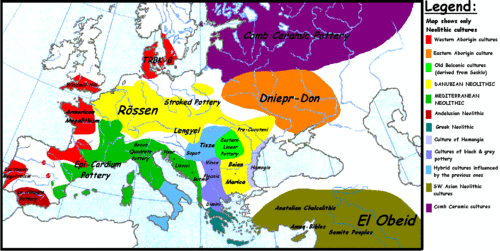

- 4650: Oldest neolithic village in France, Courthézon in the Vaucluse.
- 4000: Neolithic Chasséen culture village of Bercy.
- 3610: Appearance of first megaliths in France.
- 3430: Chasséen culture village of Saint-Michel du Touch near Toulouse.
- 3430: Appearance of Rössen culture at Baume de Gonvilla in Haute-Saône.
- 3250: Expansion of Chasséen culture in the south of France, from the Lot to the Vaucluse.
- 3190: Chasséen culture in Calvados.
- 2530: Chasséen culture in Pas-de-Calais.
- 2450: End of Chasséen culture in Eure-et-Loir.
- 2400: End of Chasséen culture in Saint-Mitre (in Reillanne, Alpes-de-Haute-Provence).
- 2300: Village at Ponteau (in Martigues, Provence) of the Beaker culture.
- 1800: Beginning of Bronze Age in France.
- 800: Appearance in France, via the Rhine and the Moselle, and expanding into Champagne and Bourgogne of the Urnfield culture.
- 725: Beginning of Hallstatt culture.
- 680: Founding of Antibes, the first Greek colony in France.
- 600: Founding of Massalia (future Marseille) by the Greeks from the Ionian city of Phocaea.
- 450: The Celts of la Tène appear in Champagne. They expand to the Garonne, forming what will come to be called the Gaul civilization.
- 390: The Celtic chief Brennus sacks Rome.
- 121: Roman occupation of Gallia Narbonensis.
- 118: Founding of the Roman colony Narbo Martius (future Narbonne).
- 58-51: Conquest of Gaul by Julius Caesar.
See also
- Timeline of glaciation
- Neolithic Europe
- Old European culture
- Proto-Indo-Europeans
- Proto-Celtic language
- Prehistory of Brittany
- Prehistoric Britain
- Prehistoric Iberia
- Prehistoric Romania
- Archaeological sites in France
Sources and citations
- 1 2 Jones, Tim. "Lithic Assemblage Dated to 1.57 Million Years Found at Lézignan-la-Cébe, Southern France «". Anthropology.net. Retrieved 21 June 2012.
- 1 2 Henry de Lumley, La Grande Histoire de premiers europeens, Odile Jacob, Paris, 2010
- ↑ The date of interbreeding between Neandertals and modern humans
- ↑ http://www.nytimes.com/2011/11/03/science/fossil-teeth-put-humans-in-europe-earlier-than-thought.html?scp=1&sq=kents%20cavern&st=cse
External links
- French National Museum of Antiquities in the Château of Saint-Germain-en-Laye (in French)
- Lascaux Cave Official Lascaux Web site, from the French Ministry of Culture.
- The Dawn of Rock Art. An article summarizing the earliest known rock art, with a focus on recently discovered painted caves in Europe, Grotto Cosquer and Grotto Chauvet.
- La Tène site: brief text, illustrations (in French)
